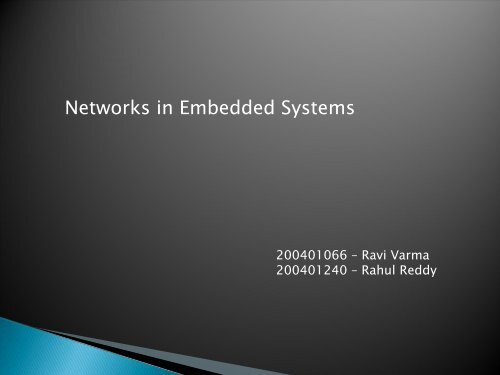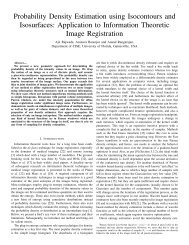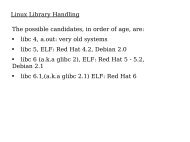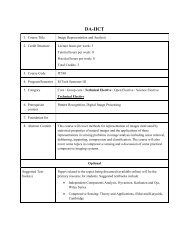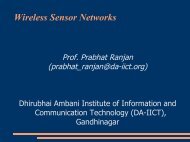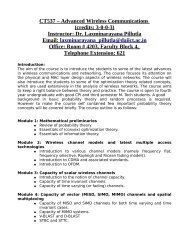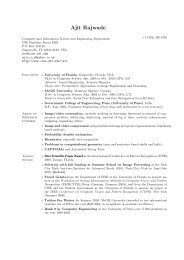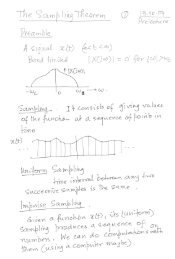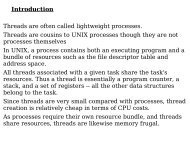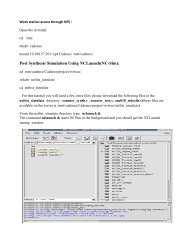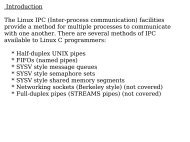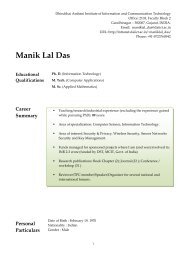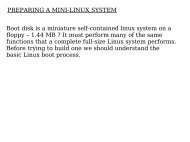Networks in Embedded Systems - DAIICT Intranet
Networks in Embedded Systems - DAIICT Intranet
Networks in Embedded Systems - DAIICT Intranet
Create successful ePaper yourself
Turn your PDF publications into a flip-book with our unique Google optimized e-Paper software.
<strong>Networks</strong> <strong>in</strong> <strong>Embedded</strong> <strong>Systems</strong><br />
200401066 – Ravi Varma<br />
200401240 – Rahul Reddy
http://www-net.cs.umass.edu/cs791_sensornets/<br />
http://www.isi.edu/scadds/papers/ICASSP-2001.ps<br />
http://wwwnet.cs.umass.edu/cs791_sensornets/papers/akyildiz2.pdf
Introduction.<br />
Sens<strong>in</strong>g tasks and applications.<br />
Characteristics of a Sensor Network.<br />
Factors Influenc<strong>in</strong>g Sensor Network Design.<br />
Communication architecture for sensor networks<br />
Different types of network<br />
Considerations for design<strong>in</strong>g protocols and<br />
Mechanisms.<br />
Conclusions.
Recent advancement <strong>in</strong> wireless communications and electronics has<br />
enabled the development of low-cost sensor networks. The sensor<br />
networks can be used for various application areas (e.g., health, military,<br />
home)<br />
In this we discuss on distributed, wireless, sensor networks which<br />
the signal process<strong>in</strong>g is distributed along with the sens<strong>in</strong>g.
Imag<strong>in</strong>e:<br />
high-rise build<strong>in</strong>gs self-detect structural faults (e.g., weld<br />
cracks)<br />
schools detect airborn tox<strong>in</strong>s at low concentrations, trace<br />
contam<strong>in</strong>ant transport to source<br />
buoys alert swimmers to dangerous bacterial levels<br />
earthquake-rubbled build<strong>in</strong>g <strong>in</strong>filtrated with robots and<br />
sensors: locate survivors, evaluate structural damage.<br />
ecosystems <strong>in</strong>fused with chemical, physical, acoustic, image<br />
sensors to track global change parameters.<br />
battlefield spr<strong>in</strong>kled with sensors that identify track<br />
friendly/foe air, ground vehicles, personnel.
Different types of sensors: seismic, low sampl<strong>in</strong>g rate<br />
magnetic, thermal, visual, <strong>in</strong>frared, acoustic and radar, able<br />
to monitor:<br />
temperature,<br />
humidity,<br />
vehicular movement,<br />
lightn<strong>in</strong>g condition,<br />
pressure,<br />
soil makeup,<br />
noise levels,<br />
the presence or absence of certa<strong>in</strong> k<strong>in</strong>ds of objects,<br />
mechanical stress levels on attached objects, and<br />
the current characteristics such as speed, direction, and size of an<br />
object.
Intelligent<br />
Highways<br />
Seismic<br />
Structure<br />
response<br />
Mar<strong>in</strong>e Micro<br />
organisms<br />
Collaborative<br />
Robots<br />
Wildlife<br />
Monitor<strong>in</strong>g<br />
Many more<br />
applications……..
Streams of data<br />
Uncerta<strong>in</strong> data<br />
Large number of nodes<br />
Multi-hop network<br />
No global knowledge about the network<br />
Node failure and <strong>in</strong>terference is common<br />
Energy is the scarce resource<br />
Limited memory
Data dissem<strong>in</strong>ation Data collection
fault tolerance<br />
scalability<br />
production costs<br />
operat<strong>in</strong>g environment<br />
sensor network topology<br />
hardware constra<strong>in</strong>ts<br />
transmission media and<br />
power consumption.
Failures:<br />
lack of power,<br />
physical damage <strong>in</strong> harsh environment<br />
Interference by other objects (e.g. radios) and other<br />
sensors.<br />
Fault tolerance: the ability to susta<strong>in</strong> sensor network<br />
functionalities without any <strong>in</strong>terruption due to failures<br />
The environment is important to the fault tolerance of<br />
algorithms and protocols
# of sensors: hundreds, thousands, to millions, depend<strong>in</strong>g on the type of<br />
applications.<br />
Density can be expressed as:<br />
μ(R) = (N π R 2 ) / A<br />
where N is the number of scattered sensor nodes <strong>in</strong> region A; and R,<br />
the radio transmission range. Basically, μ(R) gives the number of nodes<br />
with<strong>in</strong> the transmission radius of each node <strong>in</strong> region A.<br />
Note: often we consider 2-dimensional space.<br />
Density also depends on the applications.
Per node cost is important for large sensor networks. It has to be kept<br />
low.<br />
Bluetooth radio system: $5 now, but still too expensive for sensors.<br />
PicoNode: targeted to be < 50c.<br />
More challeng<strong>in</strong>g, with large amount of functionalities
All components must be conta<strong>in</strong>ed <strong>in</strong> a “matchbox”<br />
Limited energy<br />
Low speed (MHz) and small OS kernel (KBs)<br />
Small memory (KBs)<br />
Transceiver (kbps, short range, feet-meters)
topology ma<strong>in</strong>tenance a challeng<strong>in</strong>g task due to<br />
# of nodes, failures, dynamics etc<br />
Pre-deployment and deployment phase: no careful plann<strong>in</strong>g.<br />
considerations:<br />
the <strong>in</strong>stallation cost,<br />
no need for any pre-organization and pre-plann<strong>in</strong>g,<br />
the flexibility of arrangement, and<br />
better self-organization and fault tolerance.<br />
Post-deployment phase<br />
topology changes are due to change <strong>in</strong> position, reachability (due to<br />
jamm<strong>in</strong>g, noise, mov<strong>in</strong>g obstacles, etc.), available energy,<br />
malfunction<strong>in</strong>g, etc<br />
How to ma<strong>in</strong>ta<strong>in</strong> the topology change?<br />
Re-deployment of additional nodes phase<br />
Add<strong>in</strong>g new sensors
In a multihop sensor network, communicat<strong>in</strong>g nodes are l<strong>in</strong>ked by a<br />
wireless medium. These l<strong>in</strong>ks can be formed by radio, <strong>in</strong>frared, or optical<br />
media.<br />
To enable global operation of these networks, the chosen transmission<br />
medium must be available worldwide.
Sensor node lifetime shows a strong dependence on battery lifetime<br />
sens<strong>in</strong>g, communication, and data process<strong>in</strong>g.<br />
Communication<br />
A sensor node expends maximum energy <strong>in</strong> data<br />
communication. This <strong>in</strong>volves both data transmission and<br />
reception.<br />
the active power + the start-up power consumption<br />
Data process<strong>in</strong>g<br />
Much less, local data process<strong>in</strong>g is crucial <strong>in</strong> m<strong>in</strong>imiz<strong>in</strong>g power<br />
consumption <strong>in</strong> a multi-hop sensor network.
distributed comput<strong>in</strong>g platform:<br />
PE<br />
network<br />
PEs may be CPUs or ASICs.<br />
PE<br />
communication l<strong>in</strong>k<br />
PE
PE<br />
more process<strong>in</strong>g<br />
<strong>in</strong>itial process<strong>in</strong>g<br />
PE sensor<br />
PE actuator
How to program ?<br />
A s<strong>in</strong>gle computer<br />
Parallel computers<br />
<strong>Networks</strong> of computers<br />
<strong>Networks</strong> of <strong>Embedded</strong> <strong>Systems</strong> (NES):-<br />
How to program NES to perform distributed tasks ?
Higher performance at lower cost.<br />
Physically distributed activities---time constants may not allow<br />
transmission to central site.<br />
Improved debugg<strong>in</strong>g---use one CPU <strong>in</strong> network to debug others.<br />
May buy subsystems that have embedded processors.
When the precise location of a signal of <strong>in</strong>terest is unknown <strong>in</strong> a<br />
monitored region, distributed sens<strong>in</strong>g allows one to place the sensors<br />
closer to the phenomena be<strong>in</strong>g monitored than if only a s<strong>in</strong>gle sensor<br />
were used.<br />
This yields higher SNR, and improved opportunities<br />
for l<strong>in</strong>e of sight. While SNR can be addressed<br />
<strong>in</strong> many cases by deploy<strong>in</strong>g one very large sensitive sensor,<br />
l<strong>in</strong>e of sight, and more generally obstructions, cannot<br />
be addressed by deploy<strong>in</strong>g one sensor regardless of its sensitivity.<br />
Thus, distributed sens<strong>in</strong>g provides robustness to environmental<br />
obstacles.
Many different types of networks:<br />
topology;<br />
schedul<strong>in</strong>g of communication;<br />
rout<strong>in</strong>g
One source, one or more dest<strong>in</strong>ations, no data switch<strong>in</strong>g (serial port):<br />
PE 1 PE 2 PE 3<br />
l<strong>in</strong>k 1 l<strong>in</strong>k 2
Common physical connection:<br />
PE 1 PE 2 PE 3 PE 4<br />
header address data ECC packet format
Fixed: Same order of resolution every time.<br />
Fair: every PE has same access over long periods.<br />
round-rob<strong>in</strong>: rotate top priority among Pes.<br />
fixed A B C A B C<br />
round-rob<strong>in</strong><br />
A,B,C<br />
A B C B C<br />
A<br />
A,B,C
<strong>in</strong>1 <strong>in</strong>2 <strong>in</strong>3 <strong>in</strong>4<br />
out4<br />
out3<br />
out2<br />
out1
Non-block<strong>in</strong>g.<br />
Can handle arbitrary multi-cast comb<strong>in</strong>ations.<br />
Size proportional to n 2 .
Use several stages of switch<strong>in</strong>g elements.<br />
Often block<strong>in</strong>g.<br />
Often smaller than crossbar.
Transport layer provides message-based programm<strong>in</strong>g <strong>in</strong>terface:<br />
send_msg(adrs,data1);<br />
Data must be broken <strong>in</strong>to packets at source, reassembled at<br />
dest<strong>in</strong>ation.<br />
Data-push programm<strong>in</strong>g: make th<strong>in</strong>gs happen <strong>in</strong> network based on<br />
data transfers.
Designed for low-cost, medium data rate applications.<br />
Characteristics:<br />
serial;<br />
multiple-master;<br />
fixed-priority arbitration.<br />
Several microcontrollers come with built-<strong>in</strong> I 2 C controllers.
Multiple DSPs are often connected by high-speed networks for<br />
signal process<strong>in</strong>g:<br />
DSP DSP<br />
DSP DSP
Timel<strong>in</strong>ess of the processes directly tied to the application<br />
requirements or the user perception<br />
Usage of communication bandwidth, s<strong>in</strong>ce <strong>in</strong> a radio<br />
environment bandwidth will always be scarce<br />
Complexity of the protocols and procedures: layer less?,<br />
less layers? different layers?<br />
Energy awareness
In conclusion, wireless sensor networks present fasc<strong>in</strong>at<strong>in</strong>g<br />
challenges for the application of distributed signal process<strong>in</strong>g and<br />
distributed control. These systems will challenge us to apply<br />
appropriate techniques and metrics <strong>in</strong> light of the technology<br />
opportunities (cheap process<strong>in</strong>g and sens<strong>in</strong>g nodes) and challenges<br />
(energy constra<strong>in</strong>ts).


